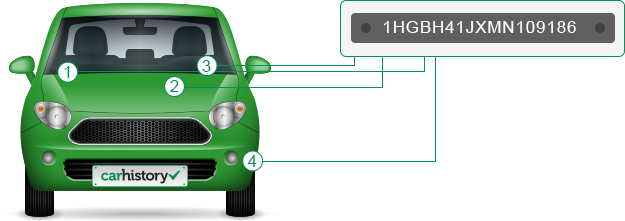
The vehicle identification number (VIN) is composed of 17 characters (digits and capital letters) that act as a unique identifier for the vehicle. A VIN displays the car's unique features, specifications and manufacturer.
The VIN can be found in a couple of places including on the car's registration label (1), on the compliance plate in the engine bay (2) or on the passenger side windshield (3), or on one of the door posts (where the door latches when it is closed) (4). See the image below:
Oversleeping in the morning is unfortunately too easy to do. Those few extra slaps on the snooze button feels like it's worth it when your eyelids are half-glued shut by sleep.
However, this means that you'll be late to work. In order to save time, you push the accelerator of your car just a little bit more to get you there faster. It is a common assumption that driving faster saves more time. While this may be true, how much time are you actually saving?
By speeding, you are putting the lives of everyone on the road, drivers and pedestrians alike, in danger.
Transport for NSW has found that between 2005 and 2013, there was an average of 30 people hospitalised by serious crashes each day. Last year accounted for 285 fatal crashes, and these statistics just represent the state of NSW alone.1
Don't put the lives of yourself and others at risk just to try and make up for your tardiness. Here's a breakdown of speeding versus time saved.
The maths behind speeding
An article by Ian Law for Wheels.ca does the maths on this:
For a 30 km drive, travelling at an average speed of 60 km per hour, it'll take 30 minutes.2
However, say you're in a rush and bump up the speed a little. Mr Law calculates that if the driver were to increase their average speed to 65 km per hour, it would shave off a mere two minutes from their drive.
He goes on to explain that these two minutes could easily be gained or lost from traffic lights or congestion.
The idea that driving saves more time is called the time-saving bias and is analysed in a study by the Hebrew University of Jerusalem.3 Their findings revealed that participants were biased when it came to estimating how much time they saved when judging distance, time and speed.
This study observes that people would overestimate the time saved if the distance was greater and if the increased speed was higher. Participants tended to focus on the new speed, as opposed to the initial speed.
As per the above case, increasing your speed of only 5 km per hour only saved two minutes, but looking at the speed of 65 km per hour alone, it appears as though it would save a significant amount of time.

Drive smarter
First off, speeding is illegal and only acceptable in emergency situations. However, while slowing down may cost you a few minutes, it'll also benefit you in many other ways.
Those few minutes you lose when driving slower can be picked up through driving smarter. Plan your drives around less congested routes or at times with fewer cars on the road.
Reducing your speed also reduces the strain from tyres, especially when going too fast and as a result, braking harder. This prolongs the life of your tyres by wearing them out less. The correct tyre pressure in your wheels also helps you to drive more economically.
Keep an eye out for red lights so you're not accelerating as fast when coming up to an intersection. This also reduces the need for braking at higher speeds, so less kinetic energy is needed to slow down. By easing off the accelerator, you save your engine from using as much fuel.
RACQ says you can save up to 25 per cent of fuel consumption if you reduce your speed by just 20 km per hour on the freeway!4
Don't make a hasty choice
Of course, every car is manufactured differently. Make sure you know the car you're going to be driving by doing a quick check on its history, especially if you're buying a used car. You'll be able to find out about the engine details, such as transmission, power and fuel type, to keep in mind when you're driving.
1Transport for NSW, Road crash analysis. Accessed December, 2015.
2Wheels.ca, How much time are you actually saving? Accessed December, 2015.
3Judgement and Decision Making, Exploring the time-saving bias. Accessed December, 2015.
4RACQ, Fuel saving tips. Accessed December, 2015.